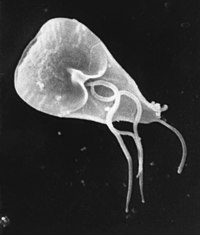
Photo from wikipedia
Little is known of the occurrence and age patterns of species/genotypes and subtypes of Cryptosporidium spp. and Giardia duodenalis in calves in Egypt. In this study, 248 fecal specimens were… Click to show full abstract
Little is known of the occurrence and age patterns of species/genotypes and subtypes of Cryptosporidium spp. and Giardia duodenalis in calves in Egypt. In this study, 248 fecal specimens were collected from dairy calves aged 1 day to 6 months on eight farms in three provinces during March 2015 to April 2016. Cryptosporidium spp. were detected and genotyped by using PCR-RFLP analysis of the small subunit rRNA (SSU rRNA) gene, while G. duodenalis was detected and genotyped by using PCR and sequence analyses of the triose phosphate isomerase (tpi), glutamate dehydrogenase (gdh) and β-giardin (bg) genes. The overall infection rates of Cryptosporidium spp. and G. duodenalis were 9.7 and 13.3%, respectively. The highest Cryptosporidium infection rate (26.7%) was in calves of age ≤ 1 month while the highest G. duodenalis infection rate (44.4%) was in calves of 2 months. Three Cryptosporidium spp. were identified, including C. parvum (n = 16), C. bovis (n = 5) and C. ryanae (n = 3), with the former being almost exclusively found in calves of ≤3 months of age and the latter two being only found in calves of over 3 months. Subtyping of C. parvum by PCR-sequence analysis of the 60 kDa glycoprotein gene identified subtypes IIaA15G1R1 (n = 15) and IIaA15G2R1 (n = 1). The G. duodenalis identified included both assemblages E (n = 32) and A (n = 1), with the latter belonging to the anthroponotic subtype A2. These data provide new insights into the genetic diversity and age patterns of Cryptosporidium spp. and G. duodenalis in calves in Egypt.
Journal Title: Parasitology international
Year Published: 2018
Link to full text (if available)
Share on Social Media: Sign Up to like & get
recommendations!